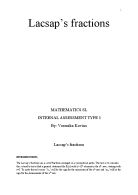According to the graphs, as the value of increases, will continuously fluctuate but start to stabilize when =8. Once reaches 23, will converge to a sustained value of 1.618033989. This value will remain constant as long as 23
The same trend is brought up by the graph of and . As the value of rises, will oscillate until reaches 25. Only then will the value of converge to a consistent value of 0. This value will stay the same as long as 25.
-
When trying to determine the 200th term, we couldn’t obtain a negative value, only a positive value. When the value of is still below 25, it oscillates between values which sometimes range from negative to positive values, but then as the value of increases it will converge to a constant specific positive value. That means a negative value could only be obtained if
-
According to the table in question two, the exact value for the continued fraction is 1.618033989 because as the value of increases, the continued fraction’s value converges into 1.618033989 and it remains constant as long as 23.
Questions B
-
Let be 2
Let be 3
Let be 4
Conclusion: Therefore whereby
-
In line with the graphs, as the value of increases, will persistently oscillate but start to stabilize when =4. When is 14, will converge to an exact value of 2.414213562. This value will not change as long as 14
The graph of and follows the same trend in that as the value of ascends, will oscillate until reaches 15. Only then will the value of converge to a consistent value of 0. This value will stay the same as long as 15.
-
When trying to determine the 200th term, we couldn’t obtain a negative value, only a positive value. When the value of N is still below 15, it oscillates between values which sometimes range from negative to positive values, but then as the value of N increases it will converge to a constant specific positive value. In that case, N could only be a negative value if <15
-
Pursuant to the table in question two, the exact value for the continued fraction is 2.414213562 because as the value of increases, the continued fraction’s value converges into 2.414213562 and it remains constant as long as 14.
Considering the general continued fraction:
Determine a generalized statement for the exact value of any such continued fraction. For which values of k does your generalized statement hold true? How do you know? Provide evidence to support your answer.
The exact value of a continued fraction as shown above could be determined when plotting a graph. In the graph, the line will initially oscillate above and below the exact value and then finally converge to it. The point where it converges and remains constant is the exact value of the continued fraction.
This statement only holds true if and is an integer. Observe the table below.
As you may notice, as long as , whether the lines in the graphs oscillate or not, they will always converge to the continued fraction’s exact value. If k were to be a negative number, no value could be obtained because a math error occurs and k must be an integer because that is the rule of a continued fraction; if it weren’t an integer, though values could still be obtained unlike a negative k, it will no longer be considered a continued fraction.
Bibliography
END OF PORTFOLIO







